Chapter 5
Harnessing Invisible Power
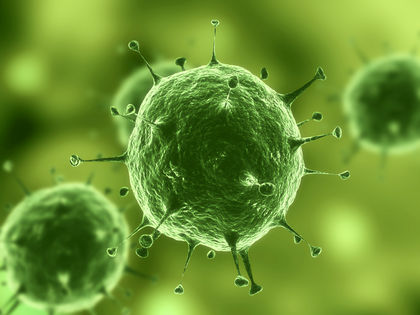
For centuries people have been using microbes to their advantage, turning grapes into wine, milk into cheese, and cabbage into sauerkraut. People benefit from what microbes do naturally: They eat. They digest organic compounds, changing the chemical makeup of one product and turning it into a completely different yet tasty food or drink.
Milk, for example, is turned into cottage cheese when the bacteria Leuconostoc break down the milk sugar (lactose) to produce lactic acid. The acid curdles the milk into cheese curds. Different types of bacteria or mold make different kinds of cheeses.
Bacteria are used in the production of all kinds of foods. Before coffee beans are washed, dried, and roasted, they are first soaked in a tank of bacteria that break down bits of shell still stuck on the bean. And without microbes, there would be no chocolate. Cocoa beans must first be fermented by bacteria and yeast before they become edible.
Louis Pasteur described the fermentation process more than one hundred years ago as the addition of a living organism such as a bacteria or yeast to another substance. Under anaerobic conditions (where no oxygen is present), the bacteria break down the carbohydrates and produce alcohol and carbon dioxide. For centuries this process has resulted in wine, beer, bread, and other good things to eat.
Genetic Engineering
Today, in order to get bacteria to produce a desired product, they are first altered through a process called genetic engineering. Bacteria are useful because their strands of DNA float loosely in the cell, making them easy to get at. They also have several plasmid rings that give a cell resistance to certain chemicals and determine what kind of materials it can break down and use for food or what enzymes it can make. Once a gene is identified, it can be taken out and inserted into another bacterium.
Genetic engineers have devised two ways to insert genetic information into a cell. One way is to use an RNA retrovirus as a vector. Just as an animal or insect vector carries a disease from person to person, a virus can be used to carry genes from one cell to another.
First the scientists must remove any harmful parts of the virus so that it will not cause disease. The desired gene or genes are then inserted inside the virus. When the virus infects the appropriate cell, the cell copies the virus's RNA, incorporating the bits of genetic information into its own DNA. Virus vectors are used to modify plants and are being experimented with for use in gene therapy for genetic disorders.
But the tool that is most commonly used in industrial genetic engineering is the bacterial plasmid, which is used to insert new genes the same way that bacteria exchange genetic information naturally. Special enzymes cut the plasmid at specific locations, opening up the DNA at precise points. A gene is taken out and replaced by a new gene that will give the bacteria the desired characteristic. It is inserted back into the plasmid and "glued" in place with another enzyme. The engineered plasmid is then reinserted back into the bacterium.
Each time the bacterium divides, the engineered plasmid is duplicated as well. When trillions of these bacteria contain the altered genes, they become powerful minifactories producing much-needed products.
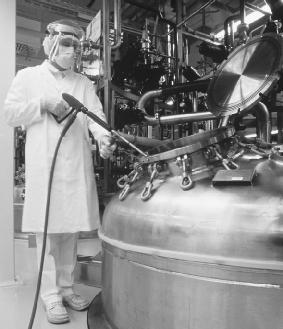
Microbial Factories
Engineered microbes are a cheap labor force. They do not take up much space or eat a lot. Massive quantities of bacteria can be grown in bioreactors—enormous stainless-steel vats several stories high, filled with a nutrient-rich substance to keep the bacteria productive. In this kind of environment bacteria churn out acids, proteins, and enzymes that are used to manufacture a whole host of products.
Using engineered microbes in an industrial setting is called bioprocessing. The first step is finding the appropriate microbe for the job and the perfect living conditions for the microbe's maximum production. A slight change in the temperature, concentration of nutrients, or level of oxygen inside the vat may diminish the bacteria's productivity.
One of the first uses of microbes in industry was the manufacture of vitamins that are added to foods or made into supplements. Many vitamins can be synthesized or made by combining certain chemicals in a lab, but others have far more complicated molecular structures. Humans normally depend on microbes to manufacture these vitamins for them as they digest food in the intestines. In the manufacturing world, bacteria are also depended on to create these essential compounds. The bacterium Bacillus subtilis is used to produce the much-needed vitamin called riboflavin, which is used by all living cells to create certain proteins. The bacterium secretes the riboflavin through its cell membrane. Once free of the bacteria, the riboflavin must be separated from the growth medium. This can be done by spinning it in a centrifuge or distilling it out. Manufactured riboflavin is added to cereals, bread, and other fortified foods.
The bacterium Lactobacillus bulgaricus makes lactic acid, which is used not only to preserve and ferment foods but also to dissolve lacquers on furniture and remove hair from cowhides before they are tanned into leather. Aspergillus niger produces vast quantities of citric acid, which is used in soft drinks, candies, inks, and Alka-Seltzer. The Bacillus subtilis bacterium is also genetically altered to produce protease, an enzyme that is added to meat tenderizers, drain cleaners, liquid glue, and laundry detergent.
High-fructose corn syrup that sweetens most soft drinks is also made with bacteria. Cornstarch is treated with a series of three enzymes to convert its sucrose into fructose, which is twice as sweet and therefore cheaper to use. The enzymes used in the process are made by bacteria.
By genetically altering a bacterium's DNA and inserting a human gene, scientists can program a bacterium to produce a human protein. The gene for making human insulin, for example, is inserted into the bacterium's chromosomes so that it begins to churn out vast amounts of insulin that is needed by people who suffer from diabetes. Other strains of bacteria have been programmed to make human growth hormone and a vaccine for hoof-and-mouth disease. Every day, researchers work on ways that bacterium can manufacture more drugs and hormones to treat other medical problems.
Feeding the World
Genetically altered bacteria and viruses are also used in agriculture. Originally, genetic engineering techniques worked well only with animal cells, because plants have tough cell walls that most bacteria can not get through. And those that can are usually harmful. But scientists found a way to take a harmful bacterium called Agrobacterium tumifaciens , which normally causes crown gall disease, and make it beneficial. The bacterium infects a plant by inserting its DNA into the plant cell, which causes a tumor to grow. But when the disease-causing gene is snipped out of the bacterium's plasmid, the bacterium is rendered harmless and becomes the perfect vector.
Viruses can also be used to modify plant genes. One such virus comes from the well-studied mosaic virus family, namely the cauliflower mosaic virus. It can be rendered harmless and fitted with genetic information that makes a plant more tolerant to herbicide or more insect resistant.
Genetically engineered foods are already on the market. Scientists have developed tomatoes that keep their fresh taste longer, peas that retain their sweetness, and strains of corn and wheat that are pest resistant. Some genetically modified potatoes contain 60 percent more starch. The extra starch decreases the amount of cooking oil that soaks into the potatoes, solving the problem of oily potato chips or greasy french fries. But more colorful tomatoes or greaseless chips are not the only reasons for this growing field of science.
Some scientists believe that genetically modified foods may be an important tool for feeding the world in the future. Researchers predict that we will need to increase global food production by 50 percent within the next fifty years in order to keep up with the population growth. That is a tall order to fill. So genetic engineers

are looking at ways to increase production; for example, developing plants that produce more food than they normally would or are able to fight off diseases that would otherwise diminish their yield.
But other scientists argue that genetically modified foods and plants are a cause for concern. They debate the safety and long-term effect that consuming modified foods will have on a person's health and the possible consequences of releasing genetically engineered recombinations into the environment. Mutations that may occur naturally within a plant will still occur within genetically modified cells. There is also the potential for naturally occurring viruses to recombine with the genetically altered viral DNA inserted into the plant. Could this cause a more virulent infection sometime in the future? As the debate continues, more than half of all food for sale in North America contains some form of genetically modified ingredients.
Biomining
The food and drug manufacturers are not the only industries that have used bacteria successfully. Another is the mining industry, which uses microbes to extract minerals from poor deposits of ore, a process dubbed biomining. The copper industry was the first to take advantage of these mini-miners. The bacterium Thiobacillus ferooxidans gets its energy by metabolizing inorganic materials. As the bacteria eat, they release a waste product of acid and an oxidizing solution of ferric ions. Together these wash the metal right out of the ore. The Romans first described this natural process two thousand years ago when they noticed that the runoff from a pile of leftover ore was blue with copper salts. The ancient miners found a way to recover the copper without ever knowing how it got there. The bacterium responsible for this phenomenon was not discovered until the 1960s. Today T. ferooxidans is used to extract more than 25 percent of all the copper mined in the world from what was once considered low-grade ore.
Gold ore, once thought to be useless for mining, is also releasing its gold deposits with the help of T. ferooxidans. A brew of microbes and fertilizer can be poured directly onto piles of crude ore. This method
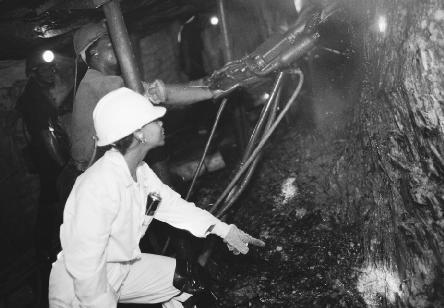
is much cheaper, more efficient, and more environmentally friendly than other extraction processes.
So far the bacteria used in mining are collected from mining areas where they occur naturally. Because biomining has become so lucrative, the next step is to create super–mining microbes through genetic engineering to make them more efficient in the mining field. Once created, they could be mixed with microbes that can, for example, withstand extreme heat or resist toxic chemicals such as arsenic and mercury, which are used in processing gold.
There are so many different kinds of bacteria with so many different behaviors that scientists are always on the lookout for bacteria with unusual appetites and attributes. If one kind of bacteria can release gold from rock or turn sugar into alcohol, then perhaps another can turn wastewater into clean water.
Clean Water
The people of New York City produce 1.4 billion gallons of wastewater every day. Part of that—between 125 and 340 million gallons—is cleaned at the North River wastewater treatment plant on the Hudson River, which takes the sewage from Manhattan and cleans it with the help of bacteria. The wastewater is pumped into five thirty-foot-deep airing tanks that stimulate the growth of oxygen-loving bacteria. These microbes consume most of the organic materials or sludge in the wastewater. Then oxygen-hating (anaerobic) bacteria are used to clean the remaining sludge. In tanks called digesters, the sludge is heated to 95 degrees Fahrenheit to promote bacterial growth. As the bacteria eat the sludge, they produce methane gas. Instead of venting the methane out into the atmosphere, the gas is used to heat the digester tanks and run the other machinery at the sewage plant. Nothing is wasted, and the bacteria do most of the work.
The Oil Eaters
Other microbes are hard at work cleaning oil spills. In March 1989, when the Exxon Valdez oil tanker spilled
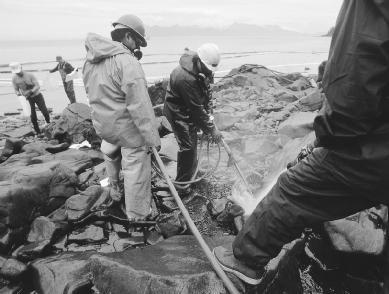
more than 11 million gallons of crude oil, it contaminated hundreds of miles of shoreline. Cleanup crews worked furiously to save the wildlife, but in the end, more than a quarter of a million birds, five thousand sea otters, and three hundred harbor seals lost their lives.
Within a few weeks, however, divers discovered that the most contaminated area in the ship's hold was thriving with sea life. Mother Nature had set out to repair herself. Naturally occurring bacteria in the water responded to the disaster and grew. They used the oil like food, changing the toxic petroleum into a harmless substance, a process that occurs only when other nutrients like nitrogen are present. Researchers learned from this discovery. Instead of washing away the oil from the shoreline with detergents that were harmful to the wildlife, they sprayed nitrogen onto the oil to encourage the growth of the oil-eating bacteria.
But cleaning that spill up was nothing compared to cleaning up the five hundred thousand tons of crude oil released into the water and soil surrounding the Mina Al-Ahmadi terminal during the 1990 Persian Gulf War. Newspapers around the world mourned the loss of plant and animal life in the region from the largest oil spill in history. Two years later, however, large mats of blue-green algae, or cyanobacteria, were growing on top of the oil-soaked soil. Embedded in the mats of cyanobacteria were millions of other bacteria, busy eating the oil and breaking it down into carbon and energy.
Researchers found a way to simulate these mats of microbes by using powdered clay sprinkled on the oil. The clay floated on the surface of the water and absorbed the oil, creating little islands where bacteria could float and feed. In one experiment, bacteria broke down three-quarters of a test spill in less than five weeks, a process that in nature would have taken closer to fifty years.
Bioremediation
In 1975 a massive leak at a military storage facility spilled eighty thousand gallons of kerosene-based jet fuel outside a quiet suburb of Charleston, South Carolina. Although the cleanup effort contained the spill, it could not prevent the fuel from seeping into groundwater. In less than ten years, highly toxic chemicals, such as cancer-causing benzene, had reached residential neighborhoods.
Studies conducted by the U.S. Geological Survey (USGS) found that microorganisms in the soil were actively consuming the toxic compounds. As they ate, they transformed the compounds into harmless carbon dioxide. By stimulating the bacteria with nutrients, the USGS team found they could increase the bacteria's activity. Through specially made infiltration systems, the nutrients were pumped into the contaminated soil. Tainted groundwater was filtered out and cleaned. In one year the contamination was reduced by 75 percent.
The process of using microbes as miniature cleanup crews is now called bioremediation, and it is big business. More than fifty bioremediation companies use microbes to clean the soil at former industrial plants, military ammunitions sites, and old gasoline stations.
Gasoline is the most common contaminant of groundwater throughout the United States. Thousands of steel tanks buried beneath old gas stations are corroding and leaking gas into the soil. "These tanks are everywhere; it's a nationwide problem," 24 says Loring Nies, an assistant professor of environmental engineering at Purdue University. Before microbes were used, the soil had to be completely removed down to depths of several feet—an expensive and labor-intensive process.
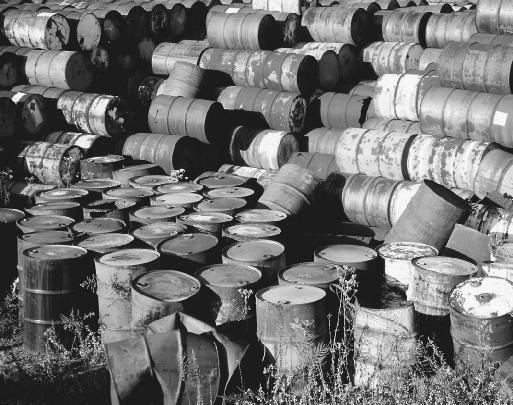
Now microbes that occur naturally in the soil are "fed" by pumping phosphorus and nitrogen into the ground, promoting rapid bacterial growth.
Another type of bacteria that likes to eat poison is cleaning up old contaminated mining sites. Gold is traditionally separated from ore using cyanide, a highly toxic substance that can kill within minutes if ingested. After processing, the cyanide is washed away and ends up in nearby streams and creeks. The Homestake Mine in South Dakota, the largest gold mine in North America, had been washing cyanide into Whitewood Creek for more than a hundred years. The creek was so polluted that it was thought to be sterile: Nothing could live in it. But when researchers tested the creek water, they found that one type of bacteria was thriving. That bacterium used the poisonous cyanide as its main food source. Now that bacterium is being used to clean up other mining sites as well.
Researchers around the world search for bacteria with useful appetites. Some, like the mining microbes, are found in nature, while others are discovered in an endless array of laboratory tests. At the University of West Florida scientists tested more than twenty thousand mutant strains of bacteria before they found one that turned a toxic industrial chemical, TCE (trichloroethylene), into a harmless substance. Today bacteria are used to detoxify soil and water polluted by PCBs (polychlorinated biphenyls), creosote, DDT, and other tough, toxic compounds.
The USGS estimates that cleaning up existing environmental contamination in the country would cost as much as $1 trillion. With bioremediation the cost may be cut drastically and the cleanup will be less stressful on the environment. But much of what bioremediation promises has yet to be realized. Designer microbes will eventually take the place of naturally occurring ones and will be able to do the job faster and more efficiently. One recent project at the Oak Ridge National Laboratory in Tennessee involved adding a bioluminescent gene to one toxin eater to make it glow so that human cleanup crews could see the bacteria at work.
Even The Guinness Book of World Record s "World's Toughest Bacterium" 25 is being put to work. Deincoccus radiodurans was discovered in 1956 inside a can of meat that had spoiled despite being sterilized by radiation. This amazing bacterium can withstand and actually grow during exposure to 3 million rads of radiation, which is more than one thousand times the amount of radiation needed to kill a human. The bacterium does become damaged during exposure, but in less than one day, it is able to repair its damaged chromosomes. Scientists working with the Department of Energy are looking into the possibility of using these microbes, or hybrids of them, to clean up radioactive sites left over from the production of nuclear weapons.
Microbes and Masterpieces
Perhaps the most astounding use of microbes can be found in the back rooms of major art institutions where the microbes' voracious appetites are being let loose on priceless masterpieces, such as the Conversion and Battle of Saint Efisio by Spinello Aretino. Many Italian works of art dating back to the fourteenth century were severely damaged during World War II. Attempts to repair them with glue and harmful cleaning solvents caused even more damage, and after sixty years they were thought to be hopelessly unrepairable.
But in 2003, researchers used microbes for the first time to remove the damaging glue. The bacterium Pseudomonas stutzeri was applied to the canvases using damp wool compresses. The bacterium quickly ate the harmful residue, almost magically revealing the original pigments underneath. Within twelve hours,
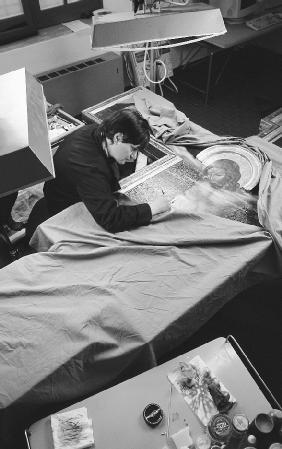
80 percent of the paintings were clean, and the figures were recognizable for the first time in many years.
Much of what microbes have been used for is cleaning up our mistakes: damaged works of art, environmental oil spills, and toxic pollution. But what does the future hold for man and microbe?
thanks,
thanks!
What about those billions dollars spending cleaning up contaminated sites? Any bacteria involve?
can you give the beneficial effects of genetically engineered bacteria for cleaning up oil spills??
i need the answer for my biotechnology assignment..
i need the answer for my assignment in biotechnology?